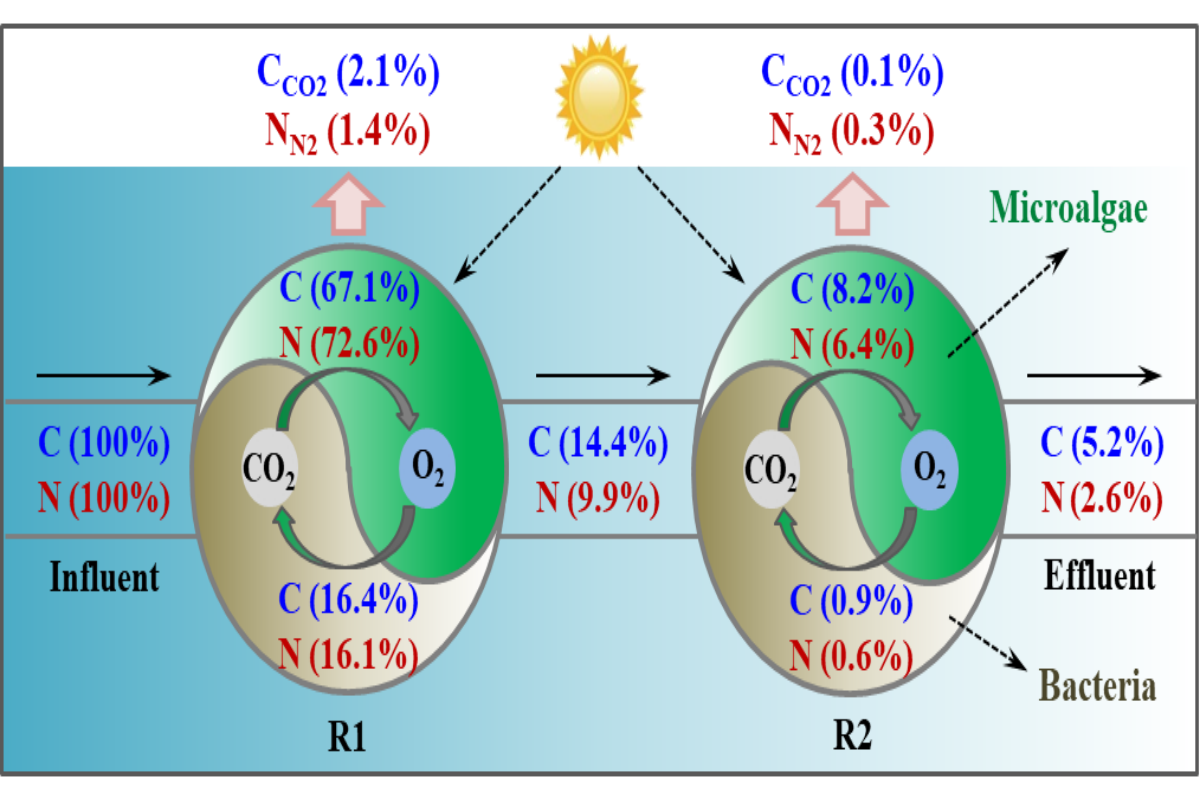南湖新闻讯(通讯员 伍贝贝)12月18日,我校资源与环境学院污水处理与资源化团队在藻菌生物膜无曝气处理灰水中碳氮质量流量和代谢途径方面的最新研究成果以“Mass Flow and Metabolic Pathway of Nonaeration Greywater Treatment in an Oxygenic Microalgal−Bacterial Biofilm”为题在Environmental Science & Technology上发表。
自产氧藻菌生物膜可实现高效低能耗的污水处理与资源化利用,揭示微藻和细菌在碳氮去除过程中的贡献和功能对于提高污染物去除性能具有重要的实践意义。然而,藻菌生物膜处理污水过程中碳(C)和氮(N)的分布、动态变化和质量流没有得到实验验证。
基于此,团队开发了一种推流式微藻-细菌生物膜反应器用于源分离灰水处理,系统研究了共生生物膜的结构和理化性质、灰水化学需氧量(COD)、LAS和总氮的去除性能,揭示了生物膜中C和N的质量流以及功能性微生物群落结构、重要酶及其代谢潜力。结果表明,绝大部分C(92.6%)和N(95.7%)固定在了新合成生物质中,只有少量部分最终转化为CO2(2.2%)和N2(1.7%)。微藻光合作用对C和N去除的贡献分别为75.3%和79.0%,而细菌同化作用对C和N去除的贡献分别为17.3%和16.7%。藻菌生物膜系统在灰水处理过程中实现了稳定高效的碳氮去除,为实现低能耗源分离灰水处理、回用和资源回收提供了一种新的技术选择。

藻菌生物膜反应器处理灰水过程中不同位置的碳和氮质量流
研究得到国家自然科学基金项目和华中农业大学高层次人才项目资助。我校资源与环境学院周云教授为论文第一作者兼通讯作者。资源与环境学院博士研究生伍贝贝、崔晓彩、硕士研究生任恬、冉婷以及美国工程院院士、亚利桑那州立大学斯威特环境生物技术中心主任Bruce E. Rittmann也参与了研究工作。
【英文摘要】
A symbiotic microalgal-bacterial biofilm can enable efficient carbon (C) and nitrogen (N) removals during aeration-free wastewater treatment. However, the contributions of microalgae and bacteria for C and N removal remain unexplored. Here, we developed a baffled oxygenic microalgal-bacterial biofilm reactor (MBBfR) for non-aerated treatment of greywater. A hydraulic retention time (HRT) of 6 h gave the highest biomass concentration and biofilm thickness, as well as the maximum removal of chemical oxygen demand (94.8%), linear alkylbenzene sulfonates (LAS, 99.7%), and total nitrogen (97.4%). HRT of 4 h caused declines of all the performance metrics due to LAS biotoxicity. Most of C (92.6%) and N (95.7%) removals were ultimately associated with newly synthesized biomass, with only minor fractions transformed into CO2 (2.2%) and N2 (1.7%) on the function of multifarious related enzymes in the symbiotic biofilm. Specifically, microalgae photosynthesis contributed to the removal of C and N at 75.3% and 79.0%, respectively, which accounted for 17.3% (C) and 16.7% (N) by bacteria assimilation. Oxygen produced by microalgae favored the efficient organics mineralization and CO2 supplying by bacteria. The symbiotic biofilm system achieved stable and efficient removal of C and N during greywater treatment, thus providing a novel technology to achieve low-energy-input wastewater treatment, reuse, and resources recovery.
审核人 周云
